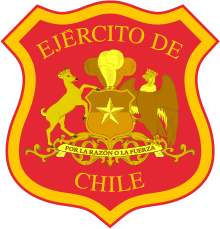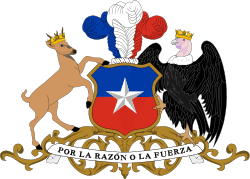Chilean Army
The Chilean Army (Spanish: Ejército de Chile) is the land arm of the Military of Chile. This 50,000 army (9,200 of which are conscripts)[2] is organized into six divisions, a special operations brigade and an air brigade.
In recent years, and after several major re-equipment programs, the Chilean Army has become one of the most technologically advanced and professional armies in America.[3][4]
The Chilean Army is mostly supplied with equipment from Germany, the Netherlands, Switzerland, the United States, Israel, France, and Spain.
History
Colonial warfare
19th century
Independence War
The National Army of Chile was created on December 2, 1810, by order of the First National Government Junta.[5] The army was actively involved in the Independence War, which was fought against royalist troops in battles such as Yerbas Buenas, San Carlos, Quechereguas, Rancagua, Chacabuco and Maipú. During this period, national figures such as José Miguel Carrera, Bernardo O'Higgins and Argentinian General José de San Martín commanded the army toward definitive victory over the Spanish forces, ultimately achieving independence for the country. The Army's first commander-in-chief was José Miguel Carrera. After obtaining independence from Spain, the newly formed Republic reorganized its military structure by creating the Military Academy of Chile, which was founded by General O'Higgins in 1817.
Guardia Nacional
Diego Portales set up a civil militia, the Guardia Nacional, to end one of the worst stages of militarism in Chilean history. The militia was created in 1825 Portales developed this parallel army to compensate the army's might.[6] The Chilean Conscription Law of 1900 marked the beginning of the end of the Guardia Nacional.[7]
War of the Confederation
Occupation of Araucanía
War of the Pacific
Military emulation 1885–1914
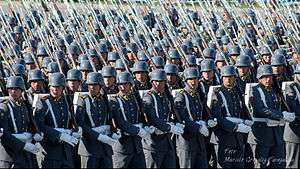
During the War of the Pacific, many high-ranking officers won valuable insights into the state of the army and became aware that the army required rebuilding. Losses, material destruction, and organizational flaws regarding strategic planning and officer training, were noted by officers like Emilio Sotomayor and Patricio Lynch, who approached President Santa María arguing the need of good schools and technical departments for the military. Other factor that supported the emulation, the deliberate systematic imitation of the military technology, organisation, and doctrine of one country by another[Notes 1] was the danger of war with Argentina. The emulation was backed by a broad coalition of civil and military leaders.
Chile hired a French military training mission in 1858,[8]:129 and the Chilean legation in Berlin was instructed to find a training mission during the War of the Pacific in 1881. But large-scale emulation of the Prussian Army began in 1886 with the appointment of Captain Emil Körner, a graduate of the renowned Kriegsakademie in Berlin. Also appointed were 36 Prussian officers to train officer cadets in the Chilean Military Academy. The training occurred in three phases; the first took place from 1885 to 1891 during the presidency of Domingo Santa María, the second was the post-civil-war phase, and the third was the 1906 reorganization.[8]:128-
The emulation was focused in armaments, conscription, officer recruitment and instruction, and general staff organization as well as military doctrine (adopted 1906). It was extended also into military logistics and medical services, promotions, retirement, salary regulation and even uniforms (adopted 1904), marching styles, helmets, parades, and military music.
Armaments: Prior to 1883, the army was equipped with a variety of rifles, mostly French and Belgian origin. From 1892 to 1902, the Chilean-Argentine Arms Race, marked the peak of Chilean arms purchase. 100,000 Mauser rifles and new Krupp artillery was bought for 3,000,000 DM in 1893, 2,000,000 DM in 1895 and 15,000,000 DM in 1898. Ammunition factories and small arms manufacturing plants were established.[8]:134
Conscription: Like others armies in South America, Chile had had a small army of long-term service officers and soldiers. In 1900 Chile became the first country in Latin America to enforce a system of compulsory military service, whereby training, initially five to eighteen months (Germany: three years), took place in zones of divisional organization in order to create a solid military structure that could be easily doubled with well-trained and combat-ready reserve forces. Budgetary restrictions prevented the full impact of the law: the service fell disproportionately on the lower classes, no more than 20% of the contingent was incorporated annually, and former conscripts were not retrained periodically.[8]:137
Officer education and training: The beginning of the German mission were dedicated almost exclusively to the organization and implementation of a standardized, technically oriented military education with the essence of Moltke's German military system of continuous study of artillery, infantry, cartography, history, topography, logistics, tactics, etc., for a modern, professional and technically trained officer corps. In 1886, the "Academia de Guerra" (War Academy) was founded "to elevate the level of technical and scientific instruction of army officers, in order that they be able, in case of war, to utilize the advantages of new methods of combat and new armaments." The best alumni were candidates for general staff service. By the mid-1890s Körner organized the courses for a Noncommissioned Officers' School (Escuela de Suboficiales y Clases).[8]:139
During the 1891 Chilean Civil War Körner was removed from duty by José Manuel Balmaceda. He and his followers set sail north to join the Congressional forces in Iquique. He became chief architect of the new army and, though Estanislao del Canto formally was commander-in-chief, Körner led the rebel forces in the major clashes of the civil war.[8]:145
Chile had had a General Staff during the War of the Pacific.[9] Körner turned his attention to a permanent institution in 1893-94 that should replace the old "Inspector General del Ejército", but with control over military affairs in peacetime and wartime. It had four sections: Instruction and Discipline, Military Schools, Scientific Works (strategic and operational planning), and Administration.[8]:147-
20th century
Milicia Republicana
The Guardia Republicana or Milicia Republicana was created after the fall of the Socialist Republic of Chile in order to prevent another Coup d'Etat. On May 7, 20,000 militiamen marched past President Arturo Alessandri in the streets of Santiago. In Las Mercedes' plot, 1933, the Commander-in-Chief of the Army, Pedro Vignola called "to resist the Milicia Republicana by any means" and he was forced to retire from his post.[10] In 1936, the militia was disbanded.[10][11]
U.S. Influence
During the decades previous to the coup, the Chilean Army became influenced by the United States' anti-communist ideology in the context of various cooperation programs including the US Army School of the Americas.[12]
The Army under Pinochet
On 11 September 1973, in a watershed event of the Cold War and the history of Chile, president Salvador Allende was overthrown in a coup d’état by the Armed Forces. Paul W. Drake and Ivan Jaksic state in The Struggle for Democracy in Chile:
- The armed forces killed, imprisoned, tortured, and exiled thousands of Chileans. The military suppressed, dismantled, and purged not only political parties but also publication, unions, schools, and other bastions of the democratic opposition. Even such privileged constituencies as university professors and students encountered serious limitations on their traditional ability to voice opinions of national, or even institutional relevance. ... The military regime viewed such activities [of the Catholic Church] with distrust, if not hostility. It launched a campaign of harassment against the Catholic Church ...
- Once the military had demobilized the polity and society, the regime began implanting its vision of a new order. It set out to replace not only democratic with authoritarian politics but also statist with market-driven economics.[13]
The Army, with now Captain General Augusto Pinochet, leader of the coup, as Commander-in-chief of both the Army and the Armed Forces, led the national mobilization effort in 1978 as the Beagle conflict began to hit the country. The Army was on full alert status during the duration of the crisis.
Patricio Aylwin became elected President of the Republic on December 14, 1989. Although Chile had officially become a democracy, the Chilean military remained highly powerful during the presidency of Aylwin, and the Constitution, amended by Pinochet's regime, ensured the continued influence of Pinochet and his commanders.
21st century
As a result of tensions with neighbors during the conflict-prone 1970s and early 1980s, the Chilean Army refined existing strategic concepts and eventually formulated a plan to restructure its forces. Though wars were avoided, the threats from the 1970s and 1980s encouraged the army to address more effectively its major defense disadvantage: lack of strategic depth. Thus in the early 1980s it looked outward for a model of army organization that would best advance defensive capabilities by restructuring forces into smaller, more mobile units instead of traditional divisions. The resulting Plan Alcázar envisions three military zones in Chile, with the bulk of forces concentrated in the north, and reinforces the center and south. The plan was implemented in stages, starting in 1994. Thus Alcázar, based on threat scenarios of the past, is one of the most durable "lessons" of the past. Even with the resolution of almost all remaining territorial disputes, the restructuring agenda continued, reinforcing a conflict-based mindset in the army.[14]
Peacekeeping
Organization

Order Of Battle
Army General Headquarters, in Santiago.
Land Operations Command, headquartered in Concepcion.
- 1st Army Division: Regions II and III, with headquarters in Antofagasta.
- 2nd Motorized Division: Regions IV, V, VI, VII and Santiago Metropolitan Region with headquarters in Santiago de Chile.
- 3rd Mountain Division: Serving Regions VIII, IX, XIV, and X with headquarters in Valdivia.
- 4th Army Division: Region XI with headquarters in Coyhaique.
- 5th Army Division: Serving Region XII with headquarters in Punta Arenas.
- 6th Army Division: Serving Regions I and XV, with headquarters in Iquique.
- Army Aviation Brigade: with headquarters in Rancagua (Brigada de Aviación del Ejército). It is the Army's aviation force, composed of 4 battalions and a logistics company.
- Special Operations Brigade "Lautaro": with headquarters in Peldehue (Brigada de Operaciones Especiales "Lautaro"). It is the Army's special forces brigade, named after one of Chile's national heroes.
Training and Doctrine Command (Comando de Institutos y Doctrina)
- Army Schools' Division (División Escuelas)
- Army Education Division (División de Educación)
- Army Doctrine Division (División de Doctrina)
Force's Support Command (Comando de Apoyo de la Fuerza)
- Logistics Division, with headquarters in Santiago (División Logística del Ejército)
- Engineers Command
- Telecommunications Command
- Infrastructure Command
- Military Industry and Engineering Command
Army Independent Commands
- General Garrison Command in Santiago, serving the Santiago Metropolitan Region, reports directly to Army Headquarters
- Medical Command in Santiago
- Administration Command
Army General Staff (Estado Mayor General del Ejército)
- Chilean Military Mission to Washington
- Directorate of Intelligence
- Directorate of Operations
- Finance Directorate
- Logistics Directorate
Military Equipment
The Chilean Army has acquired a number of new systems with the goal of having a completely modernized, and largely mechanized army by 2015. The military has also modified the operational structure, creating armoured brigades throughout the entire territory and a new special operations brigade, while preserving the current divisional scheme.
Firearms
Infantry Support Weapons
| Quantity | Weapon | Origin | Notes |
| Anti-tank Guided Missile Launchers | |||
|---|---|---|---|
| 2,700 | Spike | MR/LR/ER missiles | |
| Anti-tank Recoilless Rifles | |||
| Carl Gustaf M2 Recoilless Rifle | 84 mm | ||
| M40 recoilless rifle | 106 mm / some of them are mounted on vehicles | ||
| M67 recoilless rifle | 90 mm | ||
| Anti-tank Weapons | |||
| AT4 | 84 mm | ||
Armour
| Quantity | Type | Origin | Notes | Photo |
| Tanks | ||||
|---|---|---|---|---|
| 200 | Leopard 2A4CHL | 120 mm gun. May be upgraded to 2A5CHL in the near future. | 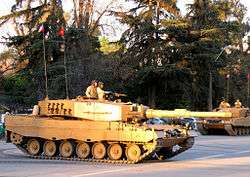 | |
| 100 | Leopard 1V | 105 mm gun | 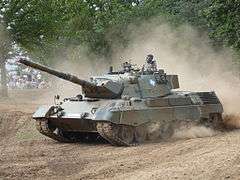 | |
| Infantry Fighting Vehicles | ||||
| 280 [15] | Marder 1A3 | 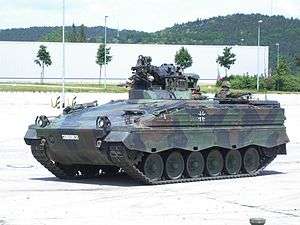 | ||
| 319 | AIFV-B/YPR-765 | Some equipped with Spike LR missiles | 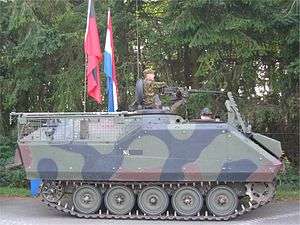 | |
| Armored personnel carrier | ||||
| 427 | M113A1/A2 | |||
| 404 | MOWAG Piranha | Built under license in Chile by FAMAE, in various configurations. | ||
| Armored Wheeled Vehicles | ||||
| 500+ | HMMWV | 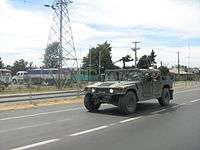 | ||
| 180 | Land Rover Defender | .jpg) | ||
| 400+ | AIL Storm | |||
| 230 | Toqui A-2 | |||
| Self-propelled Artillery | ||||
| 8 | LAR-160 | 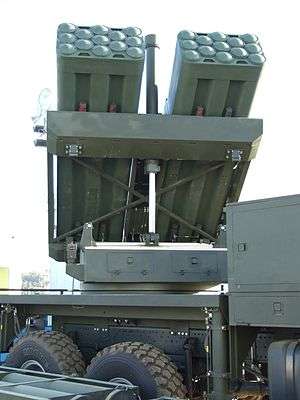 | ||
| 1 | RAYO FAMAE | |||
| 1 | SLM FAMAE | |||
| 24 | M109A5 | 24 requested in 2011, 12 delivered in 2012 and 12 more in 2015[16] |  | |
| 24 | M109 KAWEST | Bought in 2004 | ||
| 24-36 | Soltam M-71 | Bought in 1982 | ||
| 74 | M101 howitzer | 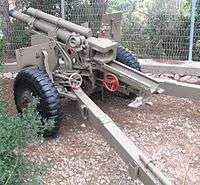 | ||
| 54 | OTO Melara Mod 56 | 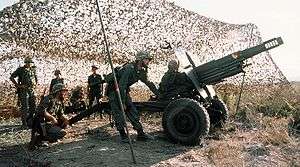 | ||
Aircraft
| Quantity[17] | Aircraft | Origin | Service versions |
| Fixed Wing | |||
|---|---|---|---|
| 2 | C-212 Aviocar | C-212-300 Aviocar | |
| 3 | CN-235 | CN-235 M-100 | |
| 3 | Cessna 208 Caravan | Cessna 208B Grand Caravan | |
| 1 | Cessna 680 Citation Sovereign | Cessna 680 Citation Sovereign | |
| Helicopters | |||
| 4 | Aerospatiale SA 330 Puma | Aerospatiale SA-330L Puma | |
| 12 | Eurocopter AS532 Cougar | Eurocopter AS-532AL Mk-1 Cougar | |
| 4 | Eurocopter AS350 | Eurocopter AS-350B3 Ecureuil | |
| 1 | Eurocopter AS355 | Eurocopter AS-355N Ecureuil 2 | |
| 9 | McDonnell Douglas MD 500 Defender | McDonnell Douglas MDD-369FF Defender | |
| Unmanned Aerial Vehicles | |||
| 6+ | BlueBird SpyLite | [18] | |
Personnel
In 2013, there were 3,900 officers, 17,300 NCOs, 3,600 professional soldiers, and 9,200 conscript soldiers. In military schools, 2,400 students. Civilian employees, 8,400.[2]
Military ranks
- Officers
| Equivalent NATO code | OF-10 | OF-9 | OF-8 | OF-7 | OF-6 | OF-5 | OF-4 | OF-3 | OF-2 | OF-1 | OF(D) and student officer | |||||||||||||||||||||||||
|---|---|---|---|---|---|---|---|---|---|---|---|---|---|---|---|---|---|---|---|---|---|---|---|---|---|---|---|---|---|---|---|---|---|---|---|---|
(Edit) |
No equivalent |  |
 |
 |
 |
 |
 |
 |
 |
 |
 |
 | ||||||||||||||||||||||||
| General de Ejército | General de División | General de Brigada | Brigadier | Coronel | Teniente Coronel | Mayor | Capitán | Teniente | Subteniente | Alférez | ||||||||||||||||||||||||||
- Enlisted
| Equivalent NATO Code | OR-9 | OR-8 | OR-7 | OR-6 | OR-5 | OR-4 | OR-3 | OR-2 | OR-1 | |||||||||||||||||||||||||||
|---|---|---|---|---|---|---|---|---|---|---|---|---|---|---|---|---|---|---|---|---|---|---|---|---|---|---|---|---|---|---|---|---|---|---|---|---|
(Edit) |
 |
 |
 |
No equivalent |  |
 |
 |
 |
No insignia | |||||||||||||||||||||||||||
| Suboficial Mayor | Suboficial | Sargento Primero | Sargento Segundo | Cabo Primero | Cabo Segundo | Soldado Primero | Soldado Segundo | |||||||||||||||||||||||||||||
Drill and traditions
The Chilean Army is famous for its elaborate drill, exhibited in large scale during the Día de las Glorias Navales on 21 May and the Parada Militar de Chile (Great Military Parade of Chile) on 19 September. The early armed forces adopted many Prussian military traditions, and it was during this period that the Chilean military had many of its most famous victories. As a result, the drill features many 19th and early 20th century Prussian and German patterns.
Participating soldiers wear stahlhelm and pickelhaube helmets and march in unaltered stechschritt. Marching music consists of Central European marches, alongside several local compositions. Each Parada Militar on 19 September ends with a playing of Preußens Gloria (played in 2007–2017), Preussischer Präsentiermarsch (first played in 2018) and Los viejos estandartes by a mounted band playing in the German tradition.
Pickelhaubes have been worn by the Military School and since recently by the 1st Cavalry Regiment and the 1st Artillery Regiment, and the stahlhelm only by the NCO School.
This is also the cases on parades held on 18 September, Independence Day, in the local level, whenever Army units take part.
Given the long list of battles fought by the Army, the following wear on parade historical dress uniforms from these times, but not march in the German manner:
- 1st Infantry Regiment "Buin" - Grenadier uniform of the 1st Infantry Battalion "Chilean Grenadiers"
- 6th Reinforced Regimient "Chacabuco" - War of the Pacific French-styled uniform worn by the 4th Company, in recognition of its heroic final stand in the Battle of La Concepcion
- 4th Motorized Infantry Brigade "Rancagua" - War of the Pacific French-styled uniform worn by the Historical Company, similar to those worn by the regiment during the 1880 Battle of Arica
Commanders-in-chief
See also
Notes
- ↑ Joao Resende-Santos in Neorealism, States, and the Modern Mass Army (page 3, 9-10) uses "emulation" instead of "prussianization" as a broader term. He says: "Crossnational emulation occurs in a wide variety of areas and by an equal variety of state and nonstate entities ... Emulation in all forms, by firms or states whether in economic or military areas is driven by the same pressures of competition and based in the same political criterion"
References
- ↑ http://www.ejercito.cl/?menu&cid=17
- 1 2 3 "Memoria del Ejército de Chile 2013". 8 January 2015. p. 381. Retrieved 6 April 2015.
- ↑ "About this Collection - Country Studies". loc.gov. Retrieved 9 May 2018.
- ↑ "Chile". state.gov. Retrieved 9 May 2018.
- ↑ "Archived copy". Archived from the original on 2008-12-19. Retrieved 2008-12-02.
- ↑ Memoria Chilena, Guardia Nacional, retrieved on 4 December 2012
- ↑ Rberto Hernández Ponce, La Guardia Nacional de Chile. Apuntes sobre su origen y organización, 1808-1848, Universidad Católica de Chile, retrieved on 4 December 2012
- 1 2 3 4 5 6 7 Resende-Santos 2007
- ↑ William F. Sater; Holger H. Herwig (1999). The Grand Illusion: The Prussianization of the Chilean Army. U of Nebraska Press. pp. 204–. ISBN 0-8032-2393-5.
- 1 2 Luis Vitale, Intervenciones militares y poder fáctico en la política chilena, de 1830 al 2.000, Santiago, 2000
- ↑ Juan Bragassi H, Las Milicias Republicanas de Chile, retrieved on 4 December 2012
- ↑ Sagredo, Rafael; Gazmuri, Cristián, eds. (2005), Historia de la vida privada en Chile (in Spanish), 3: El Chile contemporáneo. De 1925 a nuestros días (4th ed.), Santiago de Chile: Aguilar Chilena de Ediciones, ISBN 956-239-337-2
- ↑ Paul W. Drake; Ivan Jaksic (1995). The Struggle for Democracy in Chile. U of Nebraska Press. pp. 4–. ISBN 0-8032-6600-6.
- ↑ Kristina Mani, Democratization and Strategic Thinking: What the Militaries in Argentina and Chile Learned in the 1990s, Columbia University, 2003, retrieved on 4 August 2013
- ↑ http://i779.photobucket.com/albums/yy75/Dragonfly633/SolidGold0001-1.jpg
- ↑ "Chile's armed forces receive 12 M109A5 155mm self-propelled howitzers". worlddefencenews.blogspot.com. Retrieved 9 May 2018.
- ↑ World Air Forces 2013 - Flightglobal.com, pg 12, December 11, 2012 - http://www.scramblemagazine.nl/index.php?option=com_mildb&view=search&Itemid=60&af=cl
- ↑ BlueBird seals SpyLite deal with Chilean army - Flightglobal.com, April 9, 2013
Bibliography
- Resende-Santos, Joao (2007). Neorealism, States, and the Modern Mass Army. New York: Cambridge University Press. ISBN 978 - 0 - 521 - 86948 - 5.
- Bawden, John R (2016). The Pinochet Generation: The Chilean Military in the Twentieth Century. Tuscaloosa: University of Alabama Press. ISBN 978-0817319281.
External links
- Official Chilean Army site (in Spanish)
- Ranks of Chilean Army site, Chilean Army website: Chilean Army, archived from the original on 28 August 2010, retrieved 28 August 2010
- Latin American Light Weapons National Inventories
